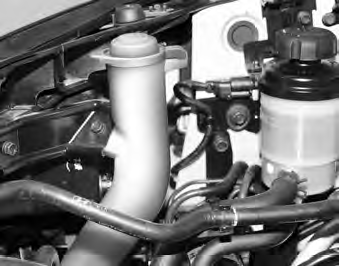Lubricants and fluids

Checking the washer fluid
level
The reservoir is translucent so that
you can check the level with a quick
visual inspection.
Check the fluid level in the washer fluid reservoir and add fluid if necessary.
Plain water may be used if washer fluid is not available.
However, use washer solvent with antifreeze characteristics in cold climates to prevent freezing.
WARNING - Coolant
ŌĆó Do not use radiator coolant or
antifreeze in the washer fluid
reservoir.
ŌĆó Radiator coolant can severely
obscure visibility when
sprayed on the windshield
and may cause loss of vehicle
control or damage to paint
and body trim.
ŌĆó Windshield Washer fluid agents contain some amounts of alcohol and can be flammable under certain circumstances.
Do not allow sparks
or flame to contact the washer
fluid or the washer fluid reservoir.
Damage to the vehicle or it's occupants could occur.
ŌĆó Windshield washer fluid is poisonous to humans and animals.
Do not drink and avoid
contacting windshield washer
fluid. Serious injury or death
could occur.
Body lubrication
All moving points of the body, such
as door hinges, hood hinges, and
locks, should be lubricated each time
the engine oil is changed. Use a nonfreezing
lubricant on locks during
cold weather.
Make sure the engine hood secondary latch keeps the hood from opening when the primary latch is released.
See also:
Two Hearts for the Soul
The five-place ŌĆ£urban crossover vehicleŌĆØ goes on sale here in March. Two
engines will be offered: a 1.6-liter four-cylinder making 122 horsepower and 115
pound-feet of torque and a 2.0-liter f ...
Door locks
Operating door locks from outside
the vehicle
ŌĆó Turn the key toward the front of the
vehicle to unlock and toward the rear of
the vehicle to lock.
ŌĆó If you lock the driverŌĆÖs door with a k ...
Introduction
How to use this manual
Fuel requirements
Vehicle break-in process
Indicator symbols on the instrument cluster ...


